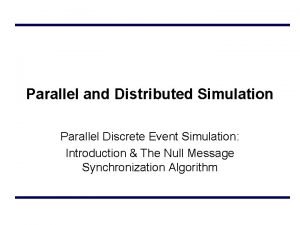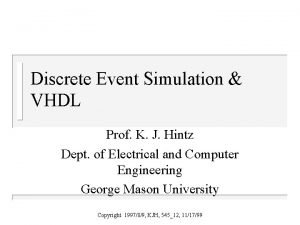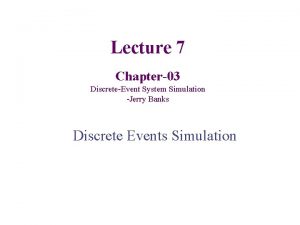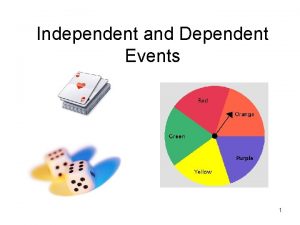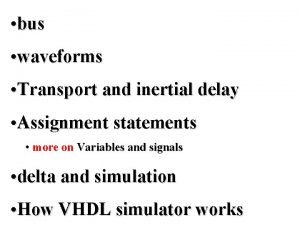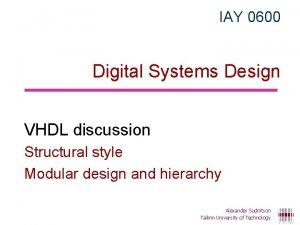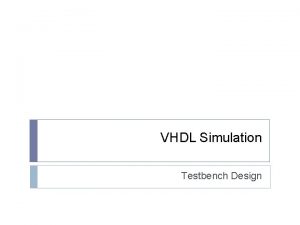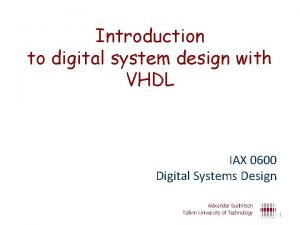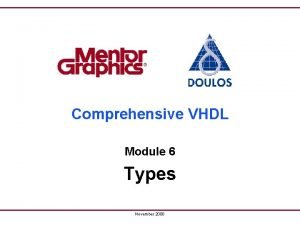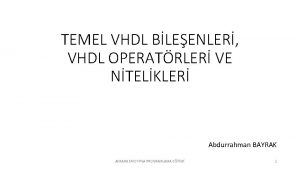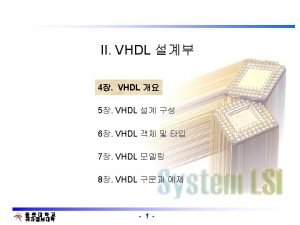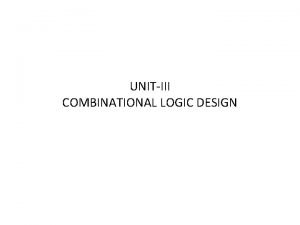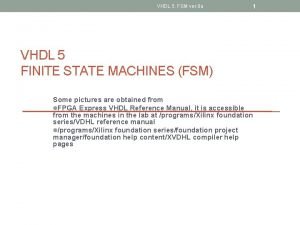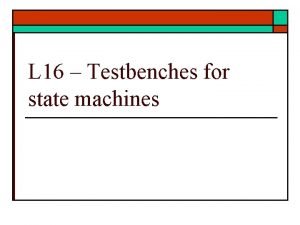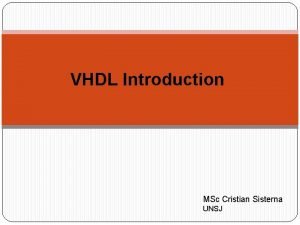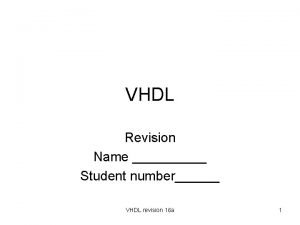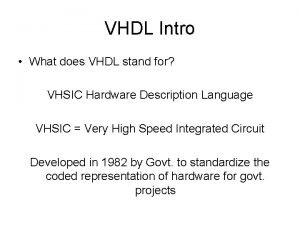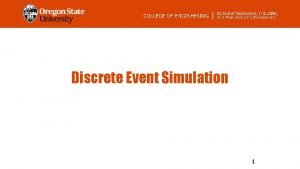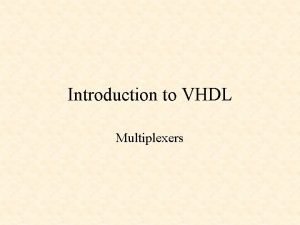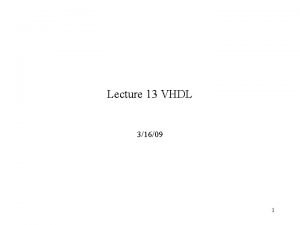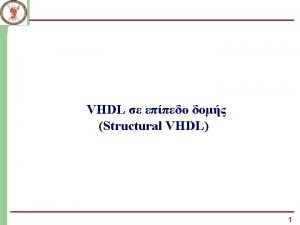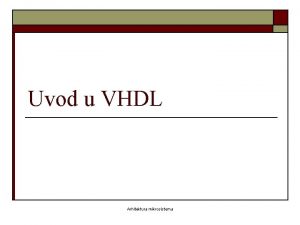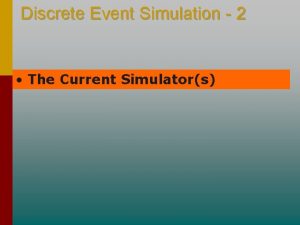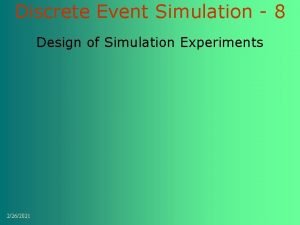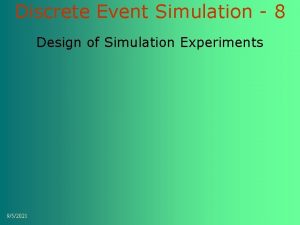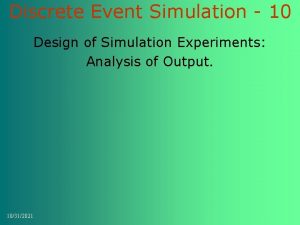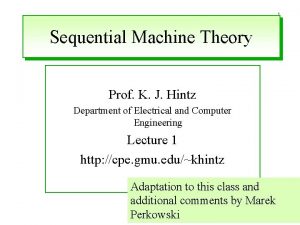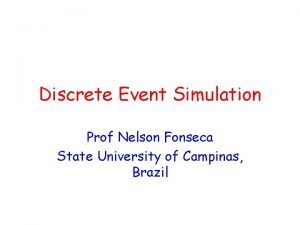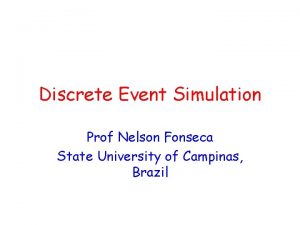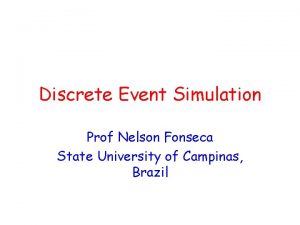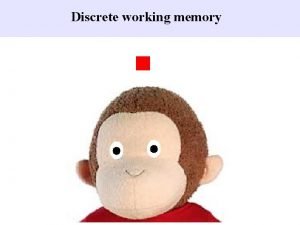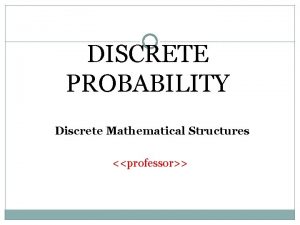Discrete Event Simulation VHDL Prof K J Hintz



























- Slides: 27

Discrete Event Simulation & VHDL Prof. K. J. Hintz Dept. of Electrical and Computer Engineering George Mason University Copyright 1997/8/9, KJH, 545_12, 11/17/99

Discrete Event Simulation • Material from VHDL Programming with Advanced Topics by Louis Baker, Wiley, 1993

Discrete Events Simulation (DES) & VHDL • VHDL is a special case of DES • Not continuous differential equation • Not finite difference equation • DES is discontinuous in time • This is efficient for various systems of big importance: • • Microprocessor/microcontroller Finite State Machine Language Recognizer Clocked/synchronous devices in general

Discrete Events Simulation Properties • Restricts Allowed Values of Signals • Restricts Transitions to the Result of Events, i. e. , It Is Causal

Why discuss DES? • Understanding Leads to Better and More Efficient Use of Simulation • Queuing of Transactions May Not Reflect Reality: • • Due to Inertial Delay Due to Transport Delay Not All Simulations Will Be Deterministic This is because of: • • • Interrupts Instruction Mix Intermediate values causing branching

Two Approaches to DES • Event Scheduling • • • Simulation proceeds from event to event This is used in VHDL Process Interaction • • • Follows customer through system Suitable for queuing systems This is used in SIMULA language

Queues • Events Ordered in Time • Many deletions of events from Queue may be expected This is due to the Default Inertial Delay •

Queues • Each driver must maintain Projected Waveform • Time and value of most recent event (s'last_event) • Next scheduled transaction • When event occurs, value before event must be saved (s'last_value) • Event time (s'last_active)

Queues • History of Signals is NOT maintained by simulation • History of signals is saved in History File • Access is only available implicitly

Efficient Simulation • Finite Propagation Delay versus Delta Delay • Finite delay more accurately reflects world. • But finite delay requires simulation to check each different delay time, therefore slow • A d-delay only needs to resolve signals after one d-delay, therefore faster • If all components had same delay, then no difference between finite delay simulation and delta simulation

Efficient Simulation • Limit Use of INOUT Ports • Use Only When Essential • Usage Limits Error Checking Associated With Port Modes • Simulation Must Resolve Direction

Efficient Simulation • Limit Use of Generics • • Generic statements require global storage Minimize Feedback • The more Layers of Feedback there are, the more Simulations are needed to resolve the output at its next state

Internal Event Queues • Necessary to Simulate Interaction With Outside World • Signals Cannot Be Used Because They Can't Represent External Events Put on a Queue • VHDL Allows Coding Your Own Event Queues

Simulation Determinism • Deterministic • Microprocessor with no interrupt doing welldefined task, e. g. , boot-up sequence, MSDOS start for x 86 • All inputs to a combinational circuit

Stochastic Simulation • More Common • Economic Simulation • Truly random #: derived from physical process • Pseudo-random: • • Generators uniform, zero mean, unit variance All other generators can be computed from this

Stochastic Simulation • Random Variables • Empirical: fit to data • Component failure, Weibull • • No justification, however fits data and easy to manipulate Function of known distribution • • Central limit theorem, summation of large number of RV approaches Gaussian Maximum of a number of RV's: Gumbel Distribution

Stochastic Simulation • Variance Reduction Techniques • The greater the variance in results, the less certain we are of their validity. • There is a square root of N improvement in variance with N, but not very efficient

Stochastic Simulation • Correlated Sampling • Vary design, but use same pseudo-random sequence of inputs • If 2 designs are equally effective, then the simulation results should be very similar

Stochastic Simulation • Correlated Sampling • Suppose Independent RVs are used to compare 2 designs and P 1 and P 2 are performance measures then a figure of merit , D= P 1 - P 2 has variance • That is, the more similar the RVs are, the smaller is sd

Stochastic Simulation • Antithetic Variables • • • Simulate using Us(0, 1) RV and save value Generate new sequence based on old by 1 -U 1, 1 -U 2, etc. If Us were particularly good sequences then you might expect 1 -Us to be particularly bad sequences

Stochastic Simulation • Stratified Sampling • Subdivide sample space into groups with minimum variance, e. g, computer instruction set • • distribution associated with business applications distribution associated with scientific applications

Stochastic Simulation • Importance Sampling • Devote more simulation runs to the sets of inputs which have greater variance • Assures that enough "rare" events occur to make sound statistical inferences

Stochastic Simulation • Sequential Analysis • Adaptively modify sampling sequence, e. g. , simulation fails when one bit is set so only test all variations with that bit set

Stochastic Simulation • Initialization • May take long time for startup transients to converge to steady state behavior • Analyze transient behavior separately • Initialize near steady state values for subsequent analysis

System Stressing • • Often interested in degradation characteristics under increasing load • Catastrophic failures • Graceful degradation Disable certain services to simulate their being fully occupied and not available

Simulation Validation • Run simple cases for which results are known or calculable and compare results • Perturb parameters to perform sensitivity analysis • • Fisher's Law: The more optimized a system is for one environment, the worse it will do in another Monte-Carlo: large # of runs, average results

Concurrent Simulation • Optimistic • Run parts concurrently but only check interaction at large time intervals. • • If an event occurred, backtrack Conservative • Each parallel process proceeds no further than it can without the possibility of backtracking
 Parallel discrete event simulation
Parallel discrete event simulation Vhdl event
Vhdl event Jerry banks simulation
Jerry banks simulation Independent event vs dependent event
Independent event vs dependent event Is a near miss a sentinel event
Is a near miss a sentinel event Swot analysis event management
Swot analysis event management Simple and compound events
Simple and compound events Bridge breaks in central java
Bridge breaks in central java Independent event vs dependent event
Independent event vs dependent event Language features of news item text
Language features of news item text Difference between signal and variable in vhdl
Difference between signal and variable in vhdl Vhdl code for combinational circuits
Vhdl code for combinational circuits Vhdl
Vhdl Vhdl modulo
Vhdl modulo Circuito secuencial
Circuito secuencial Introduction to digital system design
Introduction to digital system design Doulos numeric_std
Doulos numeric_std 4비트 bcd 가산기
4비트 bcd 가산기 Fpga eğitimi
Fpga eğitimi Vhdl entity declaration
Vhdl entity declaration Vhdl generic map
Vhdl generic map 5 to 32 decoder
5 to 32 decoder Vhdl function
Vhdl function Finite state machine vhdl testbench
Finite state machine vhdl testbench Vhdl
Vhdl Package body vhdl
Package body vhdl Vhdl
Vhdl Vhdl stand for
Vhdl stand for
